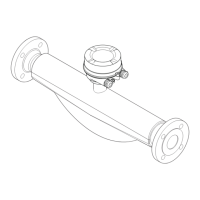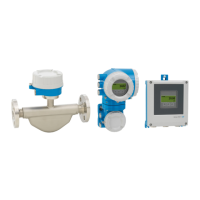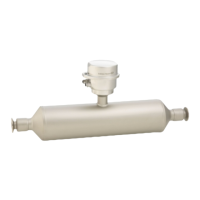Technical data Proline Promass E TB2 HART
104 Endress+Hauser
• The minimum recommended full scale value is approx. 1/20 of the maximum full scale value
• In most applications, 20 to 50% of the maximum full scale value can be considered ideal
• Select a lower full scale value for abrasive substances (such as liquids with entrained solids): flow
velocity <1 m/s (<3 ft/s).
• For gas measurement the following rules apply:
– Flow velocity in the measuring tubes should not be more than half the sonic velocity (0.5 Mach).
–
The maximum mass flow depends on the density of the gas: formula (® ä 97)
Pressure loss
To calculate the pressure loss, use the Applicator sizing tool(® ä 94)
Pressure loss in SI units
Pressure loss depends on the fluid properties and on the flow rate. The following formulas can be
used to approximately calculate the pressure loss:
Reynolds number
A0004623
Re ³ 2300 *
D rp=K· · ·
0.25 1.85 –0.86
gn
A0004626
Re < 2300
Dp=K1· · +gn
K2· ·
0.25 2
gn
r
A0004628
Dr = pressure loss [mbar]
n = kinematic viscosity [m
2
/s] g = mass flow [kg/s]
r = fluid density [kg/m
3
]
d = inside diameter of measuring tubes [m]
K to K2 = constants (depending on nominal diameter)
* To calculate the pressure loss for gases, always use the formula for Re ³ 2300.
Pressure loss coefficients
DN
d K K1 K2
[mm] [in] [m]
8 3/8
5.35× 10
–3
5.70× 10
7
7.91× 10
7
2.10× 10
7
15 ½
8.30× 10
–3
7.62× 10
6
1.73× 10
7
2.13× 10
6
25 1
12.00× 10
–3
1.89× 10
6
4.66× 10
6
6.11× 10
5
40 1½
17.60× 10
–3
4.42× 10
5
1.35× 10
6
1.38× 10
5
50 2
26.00× 10
–3
8.54× 10
4
4.02× 10
5
2.31× 10
4

